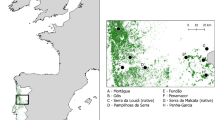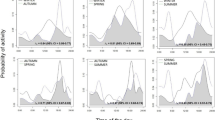Abstract
The activity of small invasive mammals, the American mink (Neovison vison) and the coypu (Myocastor coypus), was monitored in western part of Slovakia. Camera traps were located at 9 localities where these animals occur and were monitored throughout all four seasons. The activity of these two invasive species was analysed with regard to the habitat type and environment and, but especially, to the relationship to season, daily period, part of the day and activities. The following animal activities were observed: environmetal exploration, movement, swimming, stationary, grooming, play, flee, feeding, change of environment, mating behaviour and territorial marking. In case of the coypu, crepuscular and nocturnal activities were prevalent. Activity during daytime occurred mostly during winter days with low temperatures. On the other hand, American minks were mostly diurnal. The shift in behaviour compared to American minks in their native environment could be a sign of its adaptation to a new environment. Our research also showed seasonal changes in activity of both invasive mammals. This research could serve as a basis for management schemes to combat the presence and dispersal of these two invasive mammal species.




Similar content being viewed by others
References
Anděra M, Horáček I (2005) Poznáváme naše savce. 2nd edn. Sobotáles, Praha
Barrat J, Richomme C, Moinet M (2010) The accidental release of exotic species from breeding colonies and zoological collections. Rev Sci Tech off Int Epiz 29(1):113–122
Bartoszewicz M, Zalewski A (2003) American mink, Mustela vison diet and predation on waterfowl in the Slonsk Reserve, western Poland. Folia Zool 52(3):225–328
Bellard C, Cassey P, Blackburn TM (2016) Alien species as a driver of recent extinctions. Biol Lett 12:20150623
Benko Š, Chudý A, Ridzoň J (2016) Prvý priamo zaznamenaný prípad predácie kolónií vodného vtáctva norkom americkým (Neovision vison) na Slovensku. Tichodroma 28:82–85
Birks JDS, Linn IJ (1982) Studies of home range of the feral mink, Mustela vison. https://www.nhbs.com/3/series/symposia-of-the-zoological-society-of-londonSymp . Zool Soc London 49:231–257
Bobrov VV, Aľbov SA, Khlyap LA (2008) Impact of invasive mammal species on natural ecosystems: an example of the Prioksko-Terrasnyi Biosphere. Russ J Ecol 39(4):292–298
Clout MN, Russell JC (2007) The invasion ecology of mammals: a global perspective. Wildl Res 35:180–184
Craik C (1997) Long-term effects of North American Mink Mustela vison on seabirds in western Scotland. Bird Study 44(3):303–309
Craik JCA (2000) Breeding success of common gulls Larus canus in West Scotland. II Comparisons between Colonies Atlantic Seabirds 2:1–12
Davis RA, Jenson OG (1960) A note on the distribution of coypus (Myocastor coypus) in Great Britain. J Anim Ecol 29:397
Evans J (1970) About NUTRIA and their control. Bureau of Sport Fisheries and Wildlife, Denver Wildlife Research Center, Denver
Fayet AL, Hansen ES, Biro D (2019) Evidence of tool use in a seabird. PNAS 117(3):1277–1279
García P, Mateos I, Arévalo V (2009) Diurnal activity of the american mink (Neovison vison) in Central Spain. Hystrix It J Mamm 20(1):61–68
Genovesi P (2011) Are we turning the tide?. Eradications in times of crisis: how the global community is responding to biological invasions. In: Veitch CR, Clout MN, Towns DR (eds) Island invasives: eradication and management. IUCN, Gland, Switzerland, pp 5–8
Gerell R (1969) Activity patterns of the mink (Mustela vison Schreber) in southern Sweden. Oikos 20:451–460
Gosling LM (1979) The twenty-four hour activity cycle of captive coypus (Myocastor coypus). J Zool 187:341–367
Gosling LM, Baker SJ, Skinner JR (1983) A smulation aproach to investigating the response of a coypu population to climatic variation. EPPO Bulletin 13(2):183–192
Gosling LM, Baker SJ (1991) Coypu Myocastor coypus. In: Corbet GB, Harris S (eds) Handbook of British Mammals, 3rd edn. Blackwell Scientific Publications, Oxford, pp 267–275
Hammershøj M, Thomsen EA, Madsen AB (2004) Diet of free-ranging American mink in Denmark and competition with polecat and otter. Acta Theriol 49:337–347
Harrington LA, Harrington AL, Macdonald DW (2008) Estimating the relative abundance of American mink Mustela vison on lowland rivers: evaluation and comparison of two techniques. Eur J Wildl Res 54:79–87
Hrdina V, Mozdiková M, Štifel M (2013) Územný plán regiónu – Bratislavský samosprávny kraj. Ochrana prírody a tvorba krajiny vrátane prvkov ÚSES (mapa). 1:50 000. AUREX Slovakia, Bratislava.
Jojola S, Witmer Gw, Nolte D (2005) Nutria: an invasive rodent pest or valued resource?. In: Proceedings of the 11th Wildlife Damage Management Conference. https://digitalcommons.unl.edu/icwdm_wdmconfproc/110/. Accessed 22 November 2020
Kays R, Tilak S, Kranstauber B, Jansen PA, Carbone C, Rowcliffe M, Fountain T, Eggert J, He Z (2011) Camera traps as sensor networks for monitoring animal communities. IJRRWSN 1(2):19–29
Kiseleva NV (2014) Variation in the diet of American mink, Neovison vison. In: Water bodies of the Ilmen State Reserve. Russ J Ecol 45(4):322–324
Korablev NP, Korablev MP, Korablev PN, Tumanov IL (2016) Epigenetic variation in the American mink, Neovison vison, from eastern Europe: a search for factors of polymorphism. Russ J Ecol 47:289–295
Lamelas-Lopez L, Pardavila X, Amorim IR, Borges PAV (2020) Wildlife inventory from camera-trapping surveys in the Azores (Pico and Terceira islands). Biodiv Data J 8:e47865. https://doi.org/10.3897/BDJ.8.e47865
Lode T (1995) Activity pattern of polecats Mustela putorius L. in relation to food habits and prey activity. Ethology 100(4):295–308
MacArthur RA (1980) Daily and seasonal activity patterns of the muskrat Ondatra zibethicus as revealed by radiotelemetry. Ecography 3(1):1–9
Macdonald DW, King CM, Strachan R (2007) Introduced species and tie line between biodiversity conservation and naturalistic eugenics. In: Macdonald DW, Service C (eds) Key topics in conservation biology. Blackwell Publishing, Oxford, pp 187–205
Mainka SA, Howard GW (2010) Climate change and invasive species: double jeopardy. Integr Zool 5(2):102–111
Mazúr E, Lukniš M (1986) Geomorfologické členenie SSR a ČSSR. Časť Slovensko. Slovenská kartografia, Bratislava. http://geo.enviroportal.sk/atlassr/ . Accessed 18 March 2021
Melero Y, Palazon S, Revilla E, Gosalbez J (2011) Winter activity patterns in an invading mediterranean population of American mink (Neovison vison). Folia Zool 60(1):47–53
Mori E, Mancetti M, Balestrieri A (2015) Interspecific den sharing: a study on European badger setts using camera traps. Acta Ethol 18:121–126
Mori E, Andreoni A, Cecere F, Magi F, Lazzeri L (2020) Patterns of activity rhythms of invasive coypus Myocastor coypus inferred through camera-trapping. Mammal Biol 100:591–599
Niemimaa J (1995) Activity patterns and home ranges of American mink Mustela vison in the Finnish outer archipelago. Ann Zool Fenn 32:117–121
Nordstöm M, Högmander J, Nummelin J, Laine J, Laanetu N, Korpimäki E (2003) Effects of feral mink removal on seabirds, waders and passerines on small islands in the Baltic Sea. Biol Conserv 109:359–368
Normand C, Manuel J (2018) Coastal Nutria Control Program 2017–2018. https://www.nutria.com/uploads/1718CNCP_Report.pdf . Accessed 22 November 2020
Nováková M, Koubek P (2006) Diet of the American mink (Mustela vison) in the Czech Republic (Carnivora: Mustelidae). Lynx (praha) 37:173–177
Prigioni C, Balestrieri A, Remonti L (2005) Food habits of the coypu, Myocastor coypus and its impacts on aquatic vegetation in a freshwater habitat of NW Italy. Folia Zool 54:269–277
Rocha DG, Ramalho EE, Fergusson WE (2016) Baiting for carnivores might negatively affect capture rates of prey species in camera-trap studies. J Zool 300:205–212
Sidorovich VE, Macdonald DW, Pikulik MM, Kruuk H (2001) Individual feeding specialization in the European mink, Mustela lutreola and the American mink, M. vison in north-eastern Belarus. Folia Zool 50:27–42
Strachan CA, Jefferies DJ (1996) An assessment of the diet of the feral American mink Mustela vison from scats collected in areas where water voles Arvicola terrestris occur. Naturalist 121:73–81
Tolon V, Dray S, Loison A, Zeileis A, Fischer C, Baubet E (2009) Responding to spatial and temporal variations in predation risk: space use of a game species in a changing landscape of fear. Can J Zool 87:1129–1137
van Hespen R, Hauser CE, Benshemesh J, Rumpff L, Monfort JJL (2019) Designing a camera trap monitoring program to measure efficacy of invasive predator management. Wildl Res 46(2):154–164
Verbeylen G, Stuyck J (2002) Coypu (Myocastor coypus) in Flanders: will it become a pest? Bull Inst R Sc Na. Belg 72:247–248
Viviano A, Scarfò M, Mori E (2022) Temporal partitioning between forest-dwelling small rodents in a Mediterranean deciduous woodland. Animals 12(3):279
Vojar J (2007) Ochrana obojživelníků: ohrožení, biologické principy, metody studia, legislativní a praktická ochrana. Doplněk k metodice č. 1 Českého svazu ochránců přírody. ZO ČSOP Hasina, Louny
Wellman ST, Haynes JM (2009) Diel activity patterns of Mink, Neovison vison, change with habitat. Can Field-Nat 123(4):368–370
Yamaguchi N, Macdonald DW (2003) The burden of co-occupancy: intraspecific resource competition and spacing patterns in American mink, Mustela vison. J Mammal 84:1341–1355
Zielinski WJ, Spencer WD, Barrett RH (1983) Relationship between food habits and activity patterns of pine martens. J Mammal 64:387–396
Zschille J, Stier N, Roth M (2010) Gender differences in activity patterns of American mink (Neovison vison) in Germany. Eur J Wildl Res 56:187–194
Acknowledgements
We are grateful to two anonymous reviewers who helped us to improve the first version of our manuscript.
Funding
This work was conducted with funds from Comenius University Grant No. UK/325/2020.
Author information
Authors and Affiliations
Contributions
Poláčková I. and Jureček R. conceived the main idea of the research and collected the samples; Poláčková I., Šerá B. and Jureček R. processed and analysed the samples and wrote the text; Pavličková K. contributed to the writing of the manuscript. All authors read and approved the final manuscript.
Corresponding author
Ethics declarations
Ethics approval
No approval of research ethics committees was required to accomplish the goals of this study because experimental work was conducted with a non-invasive camera trap method of research.
Conflict of interest
The authors declare no competing interests.
Additional information
Publisher's Note
Springer Nature remains neutral with regard to jurisdictional claims in published maps and institutional affiliations.
Rights and permissions
About this article
Cite this article
Poláčková, I., Šerá, B., Jureček, R. et al. The daily and seasonal behaviour of the American mink and the coypu, two invasive species from the Záhorie PLA (Slovakia). acta ethol 25, 115–123 (2022). https://doi.org/10.1007/s10211-022-00396-z
Received:
Revised:
Accepted:
Published:
Issue Date:
DOI: https://doi.org/10.1007/s10211-022-00396-z




